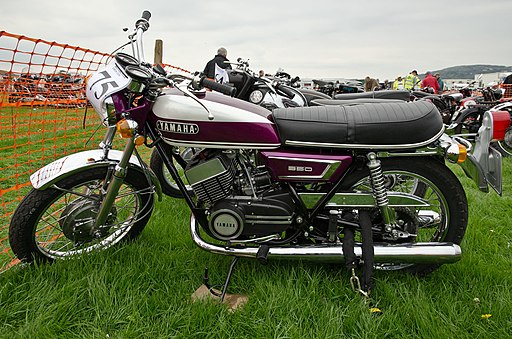Yamaha R5
The Yamaha R5 stands as a significant milestone in the history of Yamaha motorcycles, representing a transition from the brand’s early successes in two-stroke engineering to its emergence as a dominant force in the world of motorcycling. Introduced in the late 1960s, the R5 epitomized Yamaha’s commitment to innovation and performance. At its heart lay a potent air-cooled, two-stroke, twin-cylinder engine, boasting a displacement of 350cc. This powerplant delivered a punchy performance that set it apart in its era, offering riders an exhilarating blend of speed, agility, and reliability.
Built upon a sturdy frame with a telescopic front fork and twin shock absorbers at the rear, the Yamaha R5 offered a balanced and responsive ride, capable of tackling a variety of riding conditions with ease. Its lightweight construction and agile handling characteristics made it a versatile choice for riders seeking both commuting convenience and spirited weekend rides. Whether navigating crowded city streets or carving through winding country roads, the R5 exuded confidence and poise, earning accolades for its dynamic performance and rider-friendly demeanor.
Beyond its mechanical prowess, the Yamaha R5 left an indelible mark on motorcycle culture, captivating riders with its timeless design and enduring appeal. With its sleek lines, chrome accents, and signature tuning fork badge, the R5 embodied the essence of Yamaha’s racing heritage while remaining accessible to riders of all skill levels. Its enduring popularity among enthusiasts and collectors speaks to its status as a classic icon of the two-stroke era, cherished for its historic significance and the unforgettable experiences it provided to generations of riders.
Parameters Yamaha R5
The Yamaha R5, introduced in the late 1960s, was a significant motorcycle in its time. Here are its key parameters:
- Engine:
- Type: Air-cooled, two-stroke, twin-cylinder
- Displacement: 347cc
- Bore x Stroke: Approximately 64 mm x 54 mm
- Power:
- Output: Around 36 horsepower
- Transmission:
- Gearbox: Five-speed manual transmission
- Frame:
- Type: Tubular steel frame
- Suspension:
- Front Suspension: Telescopic fork
- Rear Suspension: Swingarm with twin shock absorbers
- Brakes:
- Front Brake: Drum brake
- Rear Brake: Drum brake
- Weight:
- Approximately 160-170 kg (350-375 lbs) dry weight
- Fuel System:
- Carburetion: Twin carburetors
- Performance:
- Top Speed: Varies depending on conditions and setup, typically around 160-170 km/h (100-105 mph)
- Acceleration: Respectable for its time, given its two-stroke engine characteristics
- Dimensions:
- Length: Varies depending on model year
- Width: Varies depending on model year
- Height: Varies depending on model year
- Tires:
- Front Tire: Size and brand varied depending on model year
- Rear Tire: Size and brand varied depending on model year
- Fuel Capacity:
- Equipped with a fuel tank with a capacity around 14-16 liters (3.7-4.2 gallons)
These specifications may vary slightly depending on the specific model year and any modifications made to the motorcycle. The Yamaha R5 was known for its performance, reliability, and stylish design, contributing significantly to Yamaha’s reputation as a leading motorcycle manufacturer during the 1960s and 1970s.

